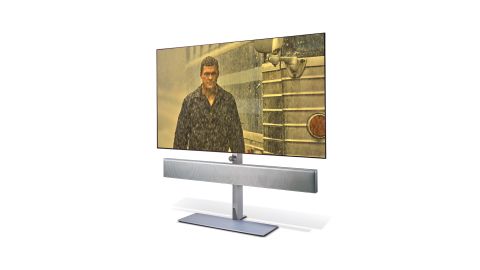The Philips 65OLED986 has a single, very bold aim – to simply be the ultimate TV. To that end, it takes last year’s Award-winning OLED806 and adds an extra picture processor, a brighter OLED panel, and a B&W speaker system consisting of Continuum-cone drivers and a Nautilus-tube tweeter.
It goes without saying that this is a real statement piece, with a price tag to match, but if you want and can afford the best, this is (currently) it.
Price
The 65OLED986’s price at launch is a hefty £3999. That makes it more than £2000 more expensive than the 65-inch version of the excellent OLED806 but that’s not a huge surprise as this flagship set is really in a whole other league in terms of specification. Sitting between these models is the new OLED936, the 65-inch version of which currently costs £2499. It features the same panel and processing as the OLED986, but its speaker bar is much more compact.
The 65OLED986 replaces the 65OLED984, which was released a little over two years ago. This new model is expected to have a similarly long life.
Design
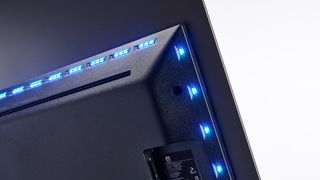
The OLED986 looks very similar to the OLED984 and that’s no bad thing – no rival can match it for style. The obvious difference between it and the average TV is that it’s floor-standing, with a height measurement of 134cm. The portion of stand below the speaker bar can be removed so that the rest can be wall-mounted, but the screen and speaker system are symbiotic – neither will work without the other. That largely makes sense – it would be crazy to go for the OLED986 if you didn’t intend to use its B&W speakers – but it’s a slight shame that any upgrade of one further down the line necessitates the discarding of the other.
The display portion of the OLED986 looks very much like any other current Philips OLED TV, with a thin black bezel running around the screen itself and an ultra-thin panel combining with a thicker enclosure on the rear for the processing hardware, amplifiers, connections and Ambilight technology, of which the TV has the four-sided version so that light is emitted beyond all four edges.
The speaker bar is just as smartly angular as the display above it, but its top panel is covered in softening grey Kvadrat fabric. The front and sides are protected by a metal grille with thousands of tiny perforations that allow sound to escape. Contained within are three forward-facing B&W drivers that utilise Continuum cones. Continuum is the same woven material used for the cones of the company’s flagship 800 Diamond range of speakers, which are used in Abbey Road Studios.
The left and right channels in the speaker bar feature their own tweeters, but the OLED986 also features a ‘tweeter-on-top’ that sits between the speaker bar and screen where it should be less susceptible to diffraction effects. The overall arrangement is very much like that of the OLED984 but, as well as the upgrade to Continuum for the main drivers, there are also upgraded amplifiers, new crossovers and improved motor assemblies, and the tweeter on top now features a Nautilus tube, which is designed to reduce the impact of the rearward sound from the driver.
Features

When we reviewed the OLED984, we noted its lack of HDMI 2.1 inputs. Thankfully, that’s been addressed for the OLED986, which boasts, alongside two standard HDMIs, two 48Gbps HDMI 2.1 connections that support a whole host of features, including eARC, ALLM (auto low-latency mode) and VRR (variable refresh rates, in all current formats).
4K at 120Hz is supported as well, though resolution with such signals is halved. Interestingly, the OLED806 can display 4K at 120Hz content in full resolution, so why can’t the OLED986? It’s apparently all down to the move to a two-chip processing engine that, Philips says, is a step up in terms of overall picture quality but lacks the ability to handle native 4K/120Hz signals. The company is essentially saying that it’s prioritised movie performance over hardcore gaming and, given the target market for the TV, that’s probably a wise decision – assuming the movie performance is all it’s cracked up to be, of course.
It certainly should be, given the raw materials in play here. The OLED806 was already a stunner in picture terms, particularly where sharpness, colours and punch are concerned, and the dual-chip version of the 5th Gen P5 processor is said to take things even further. The upgraded OLED panel is claimed to be 20 per cent brighter, too, though it’s worth noting that this is LG’s 2021 flagship panel rather than the 2022 EX OLED panel that will be hitting shops in a number of TVs, including some of Philips’, in the coming weeks and months.
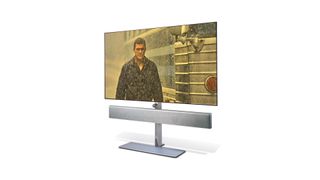
Screen type OLED
Resolution 4K
Operating system Android TV
HDR formats HDR10, HDR10+, Dolby Vision, HLG
HDMI x4 (HDMI 2.1 x2)
4K@120Hz Yes (half resolution)
VRR Yes
ALLM Yes
ARC/eARC eARC
Optical out Yes
Dimensions (hwd) inc. stand 134 x 145 x 38cm
Philips continues its laudable dedication to supporting all HDR formats, with HDR10+ and Dolby Vision both on board alongside the more common HDR10 and HLG. While Dolby Vision IQ isn’t officially supported, HDR10+ Adaptive is, and the AI-powered light sensor can adapt any and all signals to the ambient light in the room. There’s a Dolby Vision Game mode, too, which will be appreciated by Xbox Series X users, plus an HGiG setting that makes it easier to get an accurate HDR performance from many next-gen games.
While Philips TVs don’t feature the latest Google TV operating system, the version of Android TV they do use has had a number of Google TV-like elements added that make navigation more enjoyable and get you watching the specific content you’re after much quicker than before. Recommendations are much improved, too.
The app selection is unsurprisingly substantial. Netflix and Apple are on board with support for 4K, Dolby Vision and Dolby Atmos on appropriate content. The Amazon Prime Video app supports the same formats and adds HDR10+, which is its preferred format of dynamic HDR. The Disney Plus app currently doesn’t play back in Dolby Atmos (this has been an on/off issue with Android TVs for a long while now) but 4K, Dolby Vision and the IMAX picture ratio are all supported. Google Play Movies and YouTube both work in 4K HDR. All of the main catch-up services are on board as both dedicated apps and as part of the Freeview Play platform, while BT Sport gives you access to plenty of football, among other things. All of the major music streaming apps are included, too, with the exception of Apple Music. Ultimately, you’re left wanting for very little in terms of content.
Picture
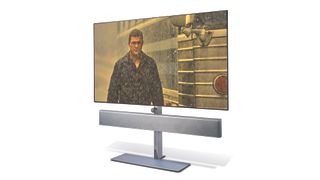
It’s common for us to complain about the out-of-the-box picture settings of Philips TVs and, while things are improving, we’re unfortunately not yet in a position to stop doing so.
The HDR Home Cinema preset, which is the default for HDR10 content, looks very impressive in some ways but is also over-processed and unnatural. The Ultra Resolution feature is the main culprit, so we recommend you switch that off first. It’s worth also dropping the Sharpness down by at least a couple of notches. We also find it best to switch off the Colour Enhancement feature altogether, but pumping the Light Boost setting to Maximum gets the most out of the extra-bright panel and switching HDR Perfect to Adaptive maximises contrast without crushing detail in either the brightest or darkest parts of the picture. We generally find that the Light Sensor is best switched off, too, but you might want to experiment with it if you'd like the screen to automatically adapt to ambient lighting conditions.
That’s quite a lot of tweaking by modern TV standards, but make the effort and you’ll be rewarded with a picture that’s genuinely exceptional. Test favourite Blade Runner 2049 has never looked better. As K enters Sapper’s farm for the first time, the light coming in through the windows is clearly brighter from the OLED986 than the OLED806 but, crucially, without there being any loss of bright detail. In fact, the subtlety of the 986’s shading means the dirt and grime on the outside of the glass – which many TVs miss altogether – is much more visible.
Shadow detail is superb, too. The OLED986 is of course capable of delivering pure blacks, but it also deftly handles near-black shades and provides oodles of insight into Sapper’s gloomy front room, even going so far as to make the musical notation on the piano near-legible. To most TVs the song book's pages are a sea of grey.
As K flies towards downtown LA, the OLED986 really gets to show off its contrast muscles, delivering the neon signs and holographic adverts with even more punch and vibrancy than the OLED806 without brightening the parts of the image that should be dark and gloomy. While this combination of light and dark is one of the Philips’ most obvious and exhilarating strengths, the subtlety of shading between the two extremes is arguably more impressive. The dingy city below K’s car is often portrayed as a flat, grey mass, but the OLED986 gives it form and solidity and makes it easy to identify specific buildings.
Just as Philips promised, the OLED986 is even sharper and more detailed than the OLED806. When Sapper removes his helmet in the film’s opening scene, the hairs, pores and creases of his face are exceptionally well rendered without being exaggerated. The Philips’ excellence with colours is evident here, too, with Sapper’s skin rendered in subtle, authentic style, while the red of his silicone gloves is luscious and vibrant.
The only part of the OLED986’s 4K HDR performance that’s anything less than exemplary is its motion, which exhibits more blur and judder when the motion processing is set to Off, Pure Cinema or Movie than the OLED806 in the same mode. Movie, in particular, is awful, whereas the differences with Off and Pure Cinema are only slight and likely won’t put you off using them. Still, it’s an odd misstep in what is otherwise a suite of upgrades.
While the OLED986 takes things a bit far, a certain amount of picture tweaking is expected when dealing with standard HDR and SDR signals. We don’t expect that to be the case with Dolby Vision, though – it should simply be a matter of choosing between Dolby Vision Dark or Dolby Vision Bright depending on ambient lighting conditions and/or one’s personal appetite for punch. Unfortunately, things aren’t so straightforward here. The Dolby Vision Bright mode, which we prefer for its extra punch, also over-sharpens the image in the way that the HDR Home Cinema preset did before our adjustments. You can (and should) switch off Ultra Resolution and reduce the Sharpness setting, but you shouldn’t have to.
There’s also a slight lack of shadow detail in both the Dolby Vision Dark and Dolby Vision Bright modes that’s not there with standard HDR10 content or with Dolby Vision from the OLED806. You can improve this somewhat by increasing Brightness but, again, you shouldn't have to, and we never quite hit upon the perfect balance of black depth and detail anyway.
That said, we’re talking fine margins here and the Dolby Vision picture performance is very strong overall. As with HDR10, its combination of superb contrast and exceptional sharpness makes for a hugely impactful image, and colours are both subtle and superbly vibrant as required.
Though we wish you could, you can’t get away with watching only HDR content, so it’s good news that the OLED986 is also a very capable handler of SDR material. You will once again need to tone down some of the set’s flashier settings, but do so and you’ll discover an image that’s still brighter and punchier than that of most rivals but that also maintains authenticity and nuance. The Philips is a confident upscaler, too, even when dealing with standard-def content. Some rivals are a little bit smoother in their delivery, but few are as detailed as the OLED986.
Sound
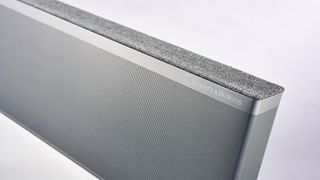
Philips and B&W see the OLED986 as not just a TV, but a complete system that can also take the place of a hi-fi. To that end, its speaker system – while advanced in terms of materials and engineering – has a relatively straightforward configuration compared to modern soundbars. There aren’t a million drivers facing all directions here – just three mid/bass drivers and three tweeters, all facing forwards. The result, somewhat predictably, is a far more authentic and natural sound than you get from most dedicated soundbars.
While we’d essentially never choose to listen to music through any other TV, it’s a pleasure via the OLED986. Playing SBTRKT’s Trials Of The Past, we’re immediately impressed by the cleanliness and rhythm of the delivery. The track requires real pace and precision, and the OLED986 has both. There’s loads of detail on offer, too, and a dynamic flexibility that no other TV and very few soundbars can match.
We wouldn’t go as far as to say that the OLED986 is a hi-fi-beater, but it is the most musical TV since its predecessor.
What’s more, the speaker system’s authenticity and naturalism are just as impressive when dealing with movie soundtracks. Rivals that fire sound in all directions can create a more enveloping sound, but none provide a truer or more balanced rendition of the source material. And that isn’t to say that the OLED986 doesn’t spread the sound around at all, because it does, the Dolby Atmos decoding (which its predecessor didn’t have) allowing sound to stretch a good way to the sides and towards the ceiling – it just doesn’t surround the listening position in the way that a soundbar such as the Sonos Arc does. That’s simply the price you pay for the OLED986’s musicality and directness.
Verdict
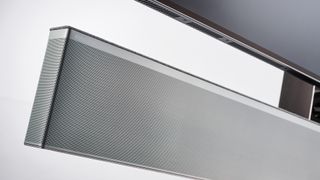
The 65OLED986 is a proposition unlike any other – except its predecessor, of course. There are plenty of TVs out there that have upgraded sound, but none that with a straight face could seriously suggest replacing your hi-fi.
Now, we wouldn’t go as far as to say you should throw away your hi-fi gear and buy the OLED986 instead, as building a system with dedicated bits of kit will always get you a better performance, and for less money. But if you are determined to have a single, super-clean and stylish system for all of your TV, movie and music needs, there’s currently nothing better.
SCORES
- Picture 5
- Sound 5
- Features 4
MORE:
Read our review of the Philips 65OLED984
Also consider the Philips 65OLED806
Read our Sony XR-65A90J review
Best 65-inch TVs 2022: the best big-screen 4K TVs you can buy
